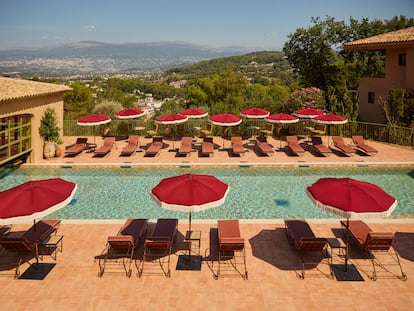A night filled with ministers, spies and guests: Inside the luxury hotel in the Old War Office in London
Under the spirit of real people such as Winston Churchill and literary figures like James Bond, the Raffles chain has turned the legendary OWO building into one of the most expensive hotels in the world. The MI5 and MI6 intelligence services were born in the basement
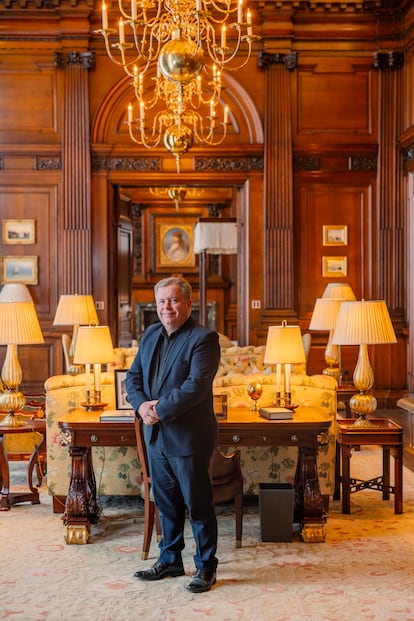
Legend has it that Vesper Lynd — the intelligent and seductive spy who captures James Bond’s heart in Casino Royale, the first novel in the saga written by Ian Fleming — was based on the Polish Jewish aristocrat Krystyna Skarbek. She adopted the English name of Christine Granville and became Winston Churchill’s favorite secret agent.
The Raffles London at the Old War Office Building — located at the heart of political power in the United Kingdom — decided to dedicate one of its majestic suites to The Spy Who Loved, as Clare Mulley titled her biography about Skarbek’s life. The book — published in 2012 — is displayed on a chest of drawers, at the entrance to a room that takes your breath away. It has wood-paneled walls, lamps and chandeliers that illuminate the space, as well as a huge brass tub and draped curtains that reveal the sophisticated luxury of the bathroom.
The Hinduja family — one of the richest in the United Kingdom, owner of the Hinduja Group business conglomerate — has wanted to leave its particular legacy in the British capital with a project that mixes history, luxury, grandeur and, above all, breathes English essence through all four sides. The family paid more than $400 million for the building, whose ultimate ownership remains in the hands of the British government. The rehabilitation and fine-tuning works have involved an expense of almost $1.6 billion.
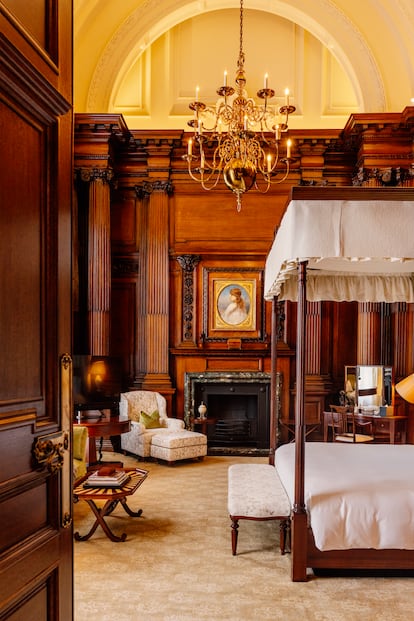
The Old War Office (OWO) is an impressive Edwardian baroque building located in the middle of Whitehall, the avenue that connects the Palace of Westminster — the meeting place of the U.K. Parliament — with Trafalgar Square. The main ministries and government offices are located on this avenue. One of its side streets is universally famous for containing the residence of the United Kingdom’s prime minister: 10 Downing Street.
In the middle of the street stands the Cenotaph: the monument to those who have fallen in all wars involving the U.K. Every year, monarchs and politicians come to pay their respects and lay their wreaths of poppies.
Whitehall is synonymous with power in British political jargon. But, until recently, it wasn’t an attractive area for large hotel chains. Raffles Hotels & Resorts — the group of luxury establishments originally from Singapore, now part of the Accor Group, a French multinational hospitality company — has teamed up with the Hindujas to revitalize the area with a building whose rehabilitation has mobilized historians, advisors, architects and decorators.
The Palace of Whitehall was once built on the same site. Its construction was ordered by Henry VIII. And, from 1906 — redesigned by architects William Young and Clyde Francis Young — it became the British War Office.
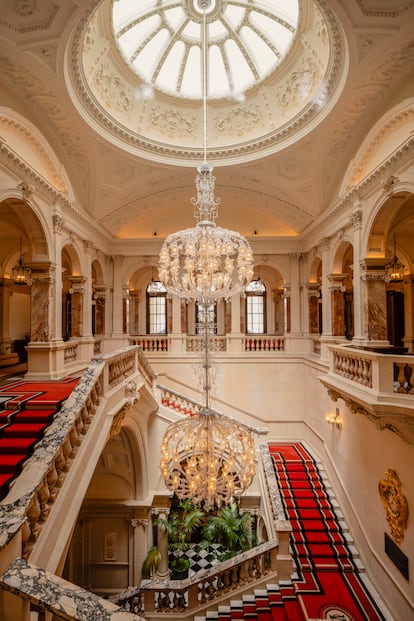
“We faced a lot of technical challenges. We had to undertake the work in an existing government office building, which was built in 1906 for a very different purpose than what’s now required,” explains Geoff Hull, the director of EPR Architects. He has spent almost eight years carrying out the project. “We wanted to build on the beauty and personality of what was already there, which was absolutely wonderful,” he adds.
The challenge was to preserve the majesty of the exterior while converting the interior into something welcoming, luxurious and sophisticated. There was a lot to hold on to. For instance, the grand imperial staircase, which leads to the second floor, where the most important suites are located. English alabaster columns, Brescia marble railing, or Italian Piastraccia marble steps. Two lions crown the beginning of the balustrade on each side. Winston Churchill would run his hand over the snout of the one on the right to seek good luck on each new day he arrived at his office.
The archaeologist, diplomat, writer and adventurer T. E. Lawrence (yes, Lawrence of Arabia) wrote to a friend — with the British irony that characterized him — to lament that “only field marshals and cleaning ladies ascended the marble stairs.” However, he did as well: he spent a lot of time in the Department of Cartography. Today, there’s a large room named after him.
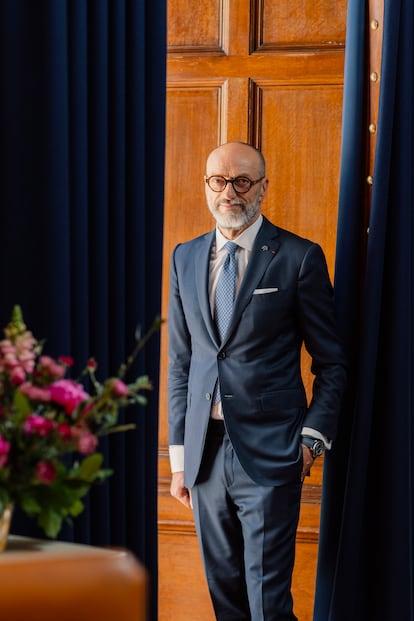
The Raffles OWO is more than just a hotel. The project — which involved adding two new floors to the existing building, as well as three underground levels — houses 120 rooms and suites with varying prices (the minimum is around $1,100 per night) and 85 private residences with access to the establishment’s services. There’s also a swimming pool, a spa — managed by the cosmetics and luxury house Guerlain — a ballroom and reception halls with capacity to accommodate 600 guests. The hotel has nine restaurants and three bars.
The star of the gastronomic offer is Mauro Colagreco’s restaurant. The Argentine chef revolutionized seasonal cooking with his restaurant on the French Riviera. “We’re interested in highlighting the produce that’s grown in the United Kingdom, to show customers that it’s versatile,” says Melissa Fergus, the restaurant’s general manager. “We like to promote a particular fruit or vegetable and pair it with the most appropriate meat or fish, to show that it can be eaten in a way that’s in tune with the seasons,” she explains, while showing EL PAÍS each of the watercolors — depicting tomatoes, asparagus, or artichokes — that accompany the menu.
The Saison restaurant — offering a Mediterranean menu by Chef Colagreco — is located where the OWO library and documentation service was operative for decades. Ian Fleming spent long afternoons there, gathering information that he would later use in his successful James Bond saga.
If you go down the grand imperial staircase, cross The Lawrence reception hall and descend the stairs — which are crowned by a group portrait of the senior naval officers from World War I — you enter a mysterious and fascinating world. The underground corridors — whose cement walls and heating pipes have remained intact — once housed the offices and secret enclosures where the British spy service was built. In that network of corridors — where the young men hired by the War Office would cycle through, quickly carrying messages and documents from one office to another — MI5 and MI6, the two legendary intelligence agencies (internal and external) of the United Kingdom, began to be created. Bond worked for the latter. There’s a semi-secret door displaying the number 007 in brass letters.
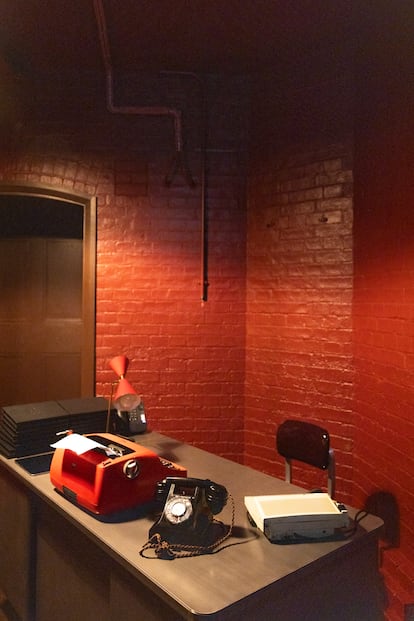
By appointment, hotel guests — as well as any visitors — can access The Spy Bar. And, behind the bar, there’s a wonderful Aston Martin DB5, used in the James Bond films. The specialty is the Vesper cocktail: a modern interpretation of a combination of gin, vodka and the French aperitif Lillet. Fleming invented it in honor of Granville, the spy with whom — as the story goes — he had a passionate and brief romance.
In the age of Instagram, it’s much-appreciated that cell phones must be handed over at the entrance to this mysterious speak-easy, to avoid photos and preserve the charm of the sophisticated nest of spies.
“We’re open to the general public 365 days a year… but additionally, as part of the contract with the government, for 10 days a year, we offer tours for anyone who wants to come by,” Philippe Leboeuf emphasizes. He’s the managing director of the hotel. “And, as for the clients, the idea of being a few steps from Big Ben or St. James’s Park fascinates them. The history that accompanies the building is so fascinating that it permeates our entire DNA,” he explains.
The recent history of the United Kingdom generates a mix of fascination and fetishism that Raffles London at the OWO fully satisfies (for those who can afford it). It’s priceless to sleep in the suite where Churchill, or the Minister of Defense Lord Haldane — responsible for modernizing the British Armed Forces — made their decisions. Equally so to inhabit the walls within which the date of D-Day — the landing at Normandy — was chosen, or to imagine the furtive encounters of Secretary of State for War John Profumo with the dancer Christine Keeler, who was also the lover of the Soviet naval attaché in the British capital, Yevgeny Ivanov, a scandal that flooded the front pages of British newspapers in the middle of the Cold War.
You can also go up on the roof of the building and contemplate — as the latest reincarnation of Bond, Daniel Craig, does in the film Skyfall — and contemplate a grandiose London. It’s the ideal setting for an exceptional hotel such as Raffles London.
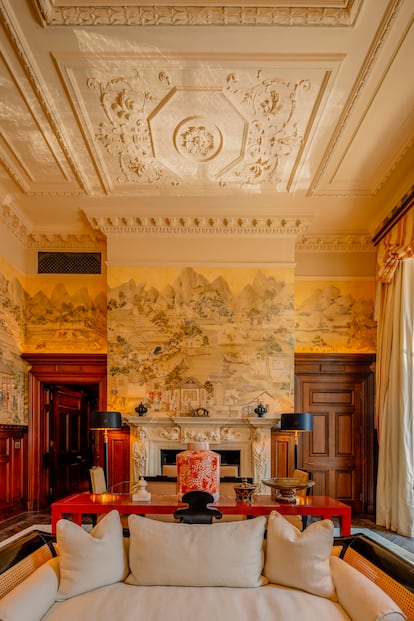
Sign up for our weekly newsletter to get more English-language news coverage from EL PAÍS USA Edition
Tu suscripción se está usando en otro dispositivo
¿Quieres añadir otro usuario a tu suscripción?
Si continúas leyendo en este dispositivo, no se podrá leer en el otro.
FlechaTu suscripción se está usando en otro dispositivo y solo puedes acceder a EL PAÍS desde un dispositivo a la vez.
Si quieres compartir tu cuenta, cambia tu suscripción a la modalidad Premium, así podrás añadir otro usuario. Cada uno accederá con su propia cuenta de email, lo que os permitirá personalizar vuestra experiencia en EL PAÍS.
¿Tienes una suscripción de empresa? Accede aquí para contratar más cuentas.
En el caso de no saber quién está usando tu cuenta, te recomendamos cambiar tu contraseña aquí.
Si decides continuar compartiendo tu cuenta, este mensaje se mostrará en tu dispositivo y en el de la otra persona que está usando tu cuenta de forma indefinida, afectando a tu experiencia de lectura. Puedes consultar aquí los términos y condiciones de la suscripción digital.
More information
Archived In
Últimas noticias
Most viewed
- Sinaloa Cartel war is taking its toll on Los Chapitos
- Oona Chaplin: ‘I told James Cameron that I was living in a treehouse and starting a permaculture project with a friend’
- Reinhard Genzel, Nobel laureate in physics: ‘One-minute videos will never give you the truth’
- Why the price of coffee has skyrocketed: from Brazilian plantations to specialty coffee houses
- Silver prices are going crazy: This is what’s fueling the rally


